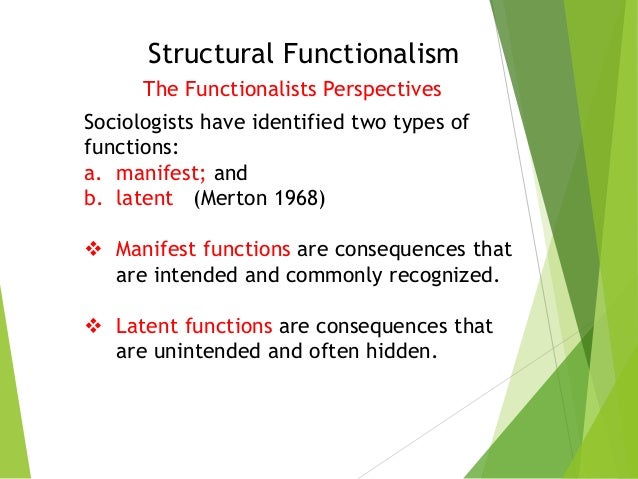Imagine sitting in a crowded coffee shop, the aroma of freshly brewed coffee filling the air, the murmur of conversations creating a gentle hum. You might be there for a quick caffeine fix, but what if this seemingly simple act of grabbing a coffee holds deeper, unanticipated consequences? This is where the concept of “latent functions” comes into play, revealing the often unseen effects of actions and social institutions.

Image: www.vrogue.co
Latent functions, in essence, are the unintended and often unrecognized consequences of social phenomena. They are like side effects of a drug – not the primary intention, but a vital part of the overall outcome. Understanding these hidden functions can be crucial in deciphering the complexities of our social world and revealing deeper insights into the workings of society.
Exploring the Hidden Layers: The Concept of Latent Functions
The term “latent function” was first introduced by sociologist Robert K. Merton in his seminal work “Social Theory and Social Structure.” He argued that social institutions and actions, beyond their obvious intended purpose, can have unforeseen consequences that shape the social fabric in subtle and often powerful ways.
The Power of Unintended Consequences
To illustrate the concept of latent functions, consider the institution of education. Its primary function is to impart knowledge and skills, preparing individuals for the workforce and a successful future. However, education also fulfills a number of latent functions:
- Socialization: Education acts as a key mechanism for socializing individuals into the norms, values, and beliefs of society. From classroom etiquette to inter-personal interactions, schools shape our social behaviors.
- Social Control: Education provides a framework for regulating behavior through rules, expectations, and the enforcement of societal norms. This can range from attendance policies to disciplinary actions.
- Networking: Education fosters connections between individuals with shared interests and goals. These connections can lead to future career advancements, personal relationships, and even political activism.
The Dynamic Duo: Manifest and Latent Functions
It’s important to distinguish between manifest functions – the intended and obvious consequences – and latent functions – the unintended and often hidden ones. For instance, a church’s manifest function is to provide a community for religious worship and spiritual guidance. Its latent function could be fostering a sense of belonging and community, facilitating social interaction, or even providing social services to those in need.

Image: tukioka-clinic.com
Beyond the Surface: Unveiling the Latent Functions in Everyday Life
Latent functions are woven into the fabric of our daily lives, operating silently in the background, shaping our interactions and experiences:
The Power of a Shared Meal
A family dinner, beyond providing sustenance, fulfills a latent function of reinforcing family bonds, promoting communication, and transmitting cultural values across generations. It’s a space for shared stories, laughter, and the forging of family traditions.
The Social Fabric of Fashion
Fashion, beyond mere aesthetics, serves a latent function of signaling social identity, status, and belonging to specific groups. The clothes we choose to wear communicate a message about ourselves, our values, and our aspirations.
The Unexpected Consequences of Technology
The internet, designed to facilitate communication and information sharing, also carries latent functions that can be both positive and negative. It fosters global connectedness, facilitates social movements, but also contributes to misinformation and the spread of harmful ideologies.
The Significance of Latent Functions
Recognizing the existence of latent functions has several key implications:
- Understanding Societal Change: By understanding both manifest and latent functions, we can better predict the unintended consequences of social change and adapt to the evolving social landscape.
- Developing Effective Social Policies: By recognizing the hidden effects of policies and programs, policymakers can work to create more impactful and equitable solutions.
- Promoting Critical Thinking: Examining the latent functions of social institutions and behaviors encourages critical thinking about the world around us. It challenges us to question assumptions and seek deeper understanding.
Looking Ahead: The Evolution of Latent Functions
As society evolves, so too do the latent functions of our institutions and practices. With the rise of social media and artificial intelligence, new and unfamiliar latent functions are emerging, demanding our attention and understanding.
The digital world, for instance, has created latent functions that influence social dynamics, shaping relationships, politics, and even global economic systems. Understanding these emerging functions is crucial to navigating the complex and ever-changing social landscape of the 21st century.
Latent Functions Are
https://youtube.com/watch?v=LcluY6UsVXY
Latent Functions: A Window into the Human Experience
The concept of latent functions serves as a powerful lens through which to understand the nuances, complexities, and interconnectedness of human social life. It reminds us that behind the seemingly obvious, there’s a hidden network of influences shaping our world, both positive and negative. By embracing the exploration of latent functions, we can gain a deeper appreciation of the intricate tapestry of the human experience.
This exploration is not just an academic exercise, but a vital tool for making informed decisions about the world we inhabit. It encourages us to look beyond the surface, to question assumptions, and to pursue a more nuanced and insightful understanding of our shared social reality.





